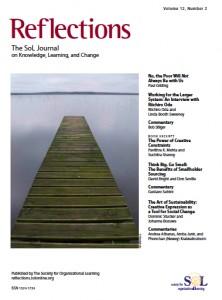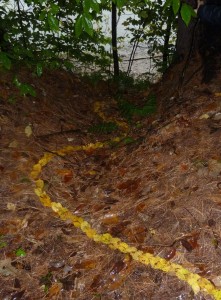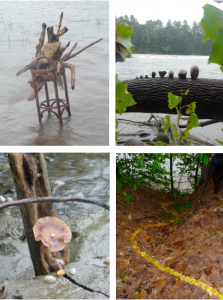Friends and colleagues Dominic Stucker and Johanna Bozuwa wrote an article about my work developing the “art of sustainability” for the Society for Organizational Learning‘s (SoL’s) Reflections Journal. Learn more and read the article, entitled “The Art of Sustainability: Creative Expression as a Tool for Social Change.”
Archive for the ‘reflection’ Category
The Art of Sustainability: Creative Expression as a Tool for Social Change
Thursday, August 9th, 2012Systems Thinking through Art in Nature
Friday, April 13th, 2012By guest writer, Dominic Stucker, Program Manager at Sustainability Leaders Network. Based on participation in several of my art in nature workshops, Dominic offers these reflections.
Systems thinking and creativity are essential for bringing about the transition to sustainability. Systems thinking helps us assemble diverse stakeholders to better understand the integrated economic, social, and environmental systems we seek to change. Creativity and art help us gain clarity in vision and tap into the breakthrough thinking necessary for innovating a new reality, a new relationship between people and planet. Fortunately, these leadership skills are mutually reinforcing, especially through making art in nature.
Immersing ourselves in nature, sitting quietly, eyes opened, eyes closed, we can hone our skills of observation, noticing patterns and processes that have evolved over millennia. Using all our senses, we can experience and learn from nature. Perhaps we see the streams, brooks, and river in a basin, noticing nature’s nested hierarchies. Or we reflect on the larger water cycle, a process that, instead of linear and polluting, is cyclical and cleansing. Gazing skyward from a soft bed of pine needles, we can observe the forest’s resilience in flexibility, trees swaying in the wind. Or we smell the pungent soil, part of annual cycle that returns sustenance to the trees’ roots. Perhaps we see the genius in a flower, tracking the sun and folding its petals at dusk; or in the capacity of a cactus to store water; or in the design of a feather. We can learn from and co-create with these natural systems.
I have had the privilege and joy of participating in several Art of Sustainability sessions with Vermont artist and educator, Jay Mead. Two that stand out were along the Housatonic River in rural Connecticut and along a wild part of the Connecticut River in Vermont. Jay invites participants to see nature anew through quiet observation, sensing, and play. The invitation includes being fully present, setting aside transient to do lists and deep-seated preconceptions about how the world works. Participants are asked to start from a place of unknowing – playful for some, meditative for others – being open for deeper wisdom to emerge.
Reflecting on Ken Robinson’s TED Talk “Do Schools Kill Creativity?”
Friday, February 10th, 2012In looking at what Ken Robinson says about creativity and how schools are currently killing this natural part of our being, it’s clear that he, along with other visionaries, believe that this industrial model of education no longer serves us. He states that “creativity is as important as literacy,” and that we should be cultivating multiple intelligences rather than the current hierarchy that favors linear thinking with math and sciences at the top and the arts at the bottom. Intelligence, as he points out, is interactive and requires openness to many ways of understanding and expression.
At Sustainability Leaders Network, our Art of Sustainability program (AoS), flows from the same framework of understanding as Ken Robinson’s talk. AoS seeks to bring back the child in all of us that in most cases have been suppressed by school and society at large. Creativity and risk-taking are at the core of this long lost child in all of us. It is the great unknowing and willingness to make mistakes that most of us have been conditioned to reject. AoS cultivates creative experiences so that participants can engage as whole people and, in doing so, find wisdom and discovery in unexpected places.
To work for sustainability on the planet, it is crucial for activists to face this challenge as whole people. To be a “whole” person” both the right and left-brain modalities need to be in sync. This can also be seen as unity of the heart and mind. AoS is intended to be a visionary tool and critical part of helping various change agents be more effective and make their work more meaningful. This is precisely the kind of work that Ken Robinson seems to be promoting.
Art of Sustainability on the Connecticut River
Tuesday, November 1st, 2011As part of the annual Dana Meadows Fellows Seminar, organized by the Sustainability Leaders Network here at Cobb Hill Cohousing, Vermont from 3-7 October, I offered a session on the art of sustainability at Sumner Falls, a wild and wooded part of the Connecticut River.
The session focused on engaging the right brain, which is closely associated with thinking outside the box and creativity. Creative problem solving is essential for addressing the many challenges we face in bringing about a sustainable future for people and planet; art and creative expression is a powerful mechanism for enhancing this capability.
I asked the group to start from a place of unknowing, of having no preconceived notions. I then asked them to observe what they saw around them, reflect, see patterns, play, and create an art piece. The recent flooding of the river meant that flotsam and jetsam were incorporated into many pieces, bringing order and beauty to the chaos. Afterwards, we toured the art pieces to hear reflections inspired by the creative process. This process of creating something out of found materials provided another method of storytelling for participants so that insights on personal and work lives emerged and were shared.
Learn more about our Art of Sustainability efforts on the Sustainability Leaders Network website.
New Work at Sculpture Fest
Wednesday, September 7th, 2011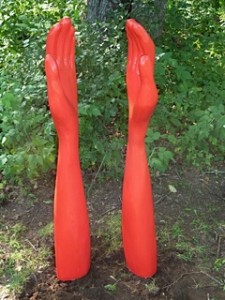
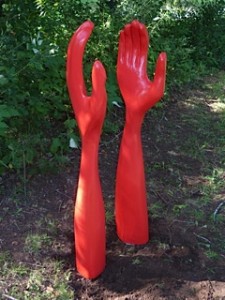
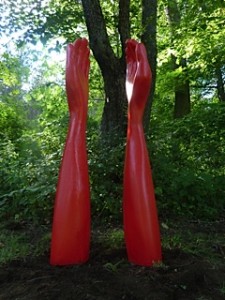
Here is a new piece I call “Red Hands.” It stands 4′ tall and was carved out of some recycled hemlock beams. Given the state of the world and even Vermont’s, in the wake of Irene’s devastation, there are many who could use a helping hand. This piece could also be about the earth’s suffering at our hands. Hopefully viewers will be provoked to think about other stories these hands tell. It is a joy to continue to show work at Sculpture Fest in Woodstock, Vermont, where I am given the freedom to site my work.

